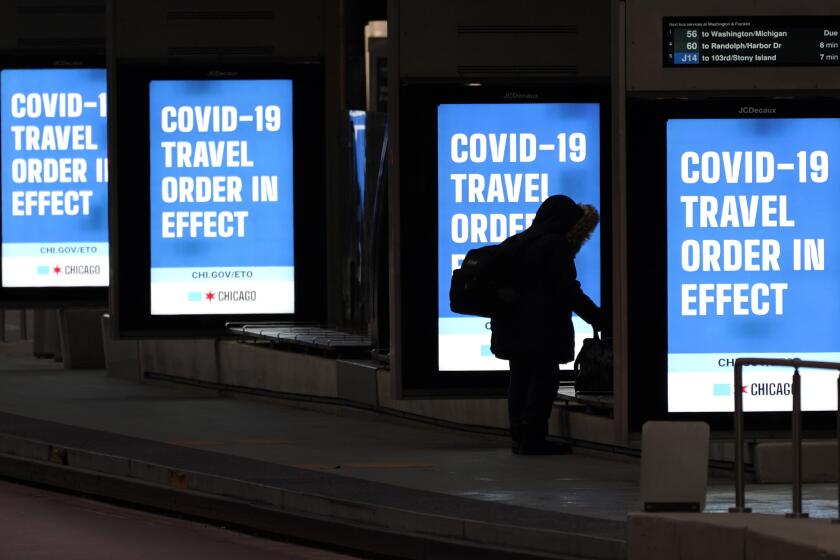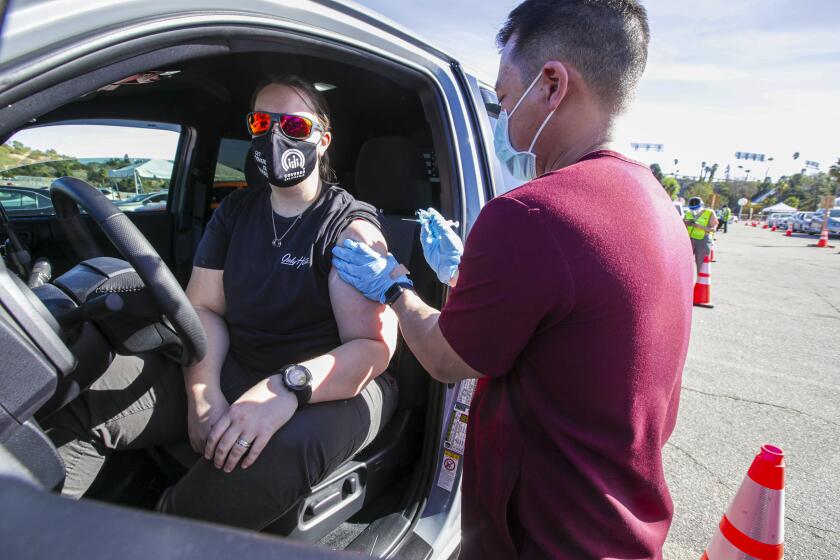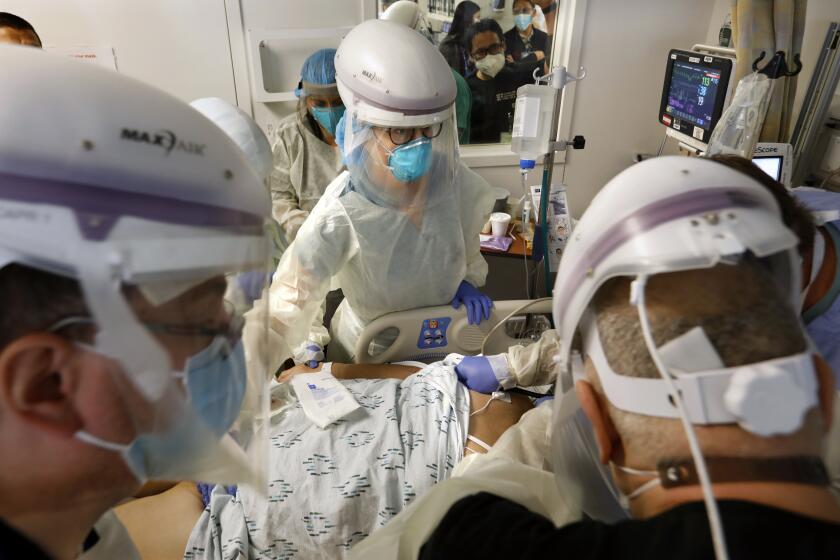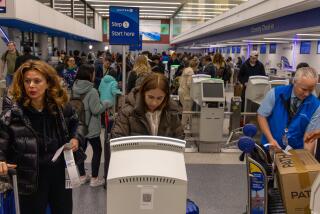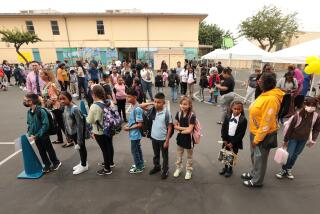Fear over COVID-19 variant grows as L.A. County mulls closing malls, gyms
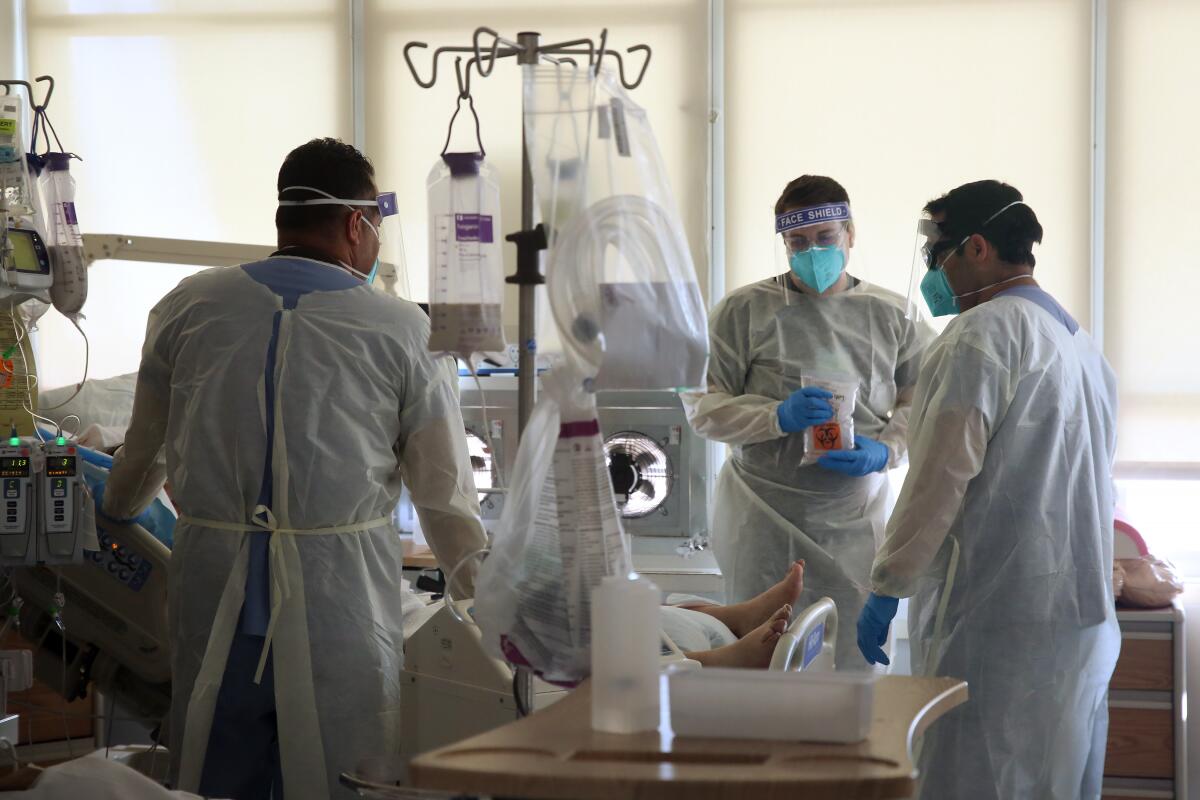
- Share via
Los Angeles County and the rest of the nation are in a race against time to vaccinate as many people as possible against the coronavirus before a variant thought to be even more contagious takes hold.
Those concerns were underscored in a U.S. Centers for Disease Control and Prevention report released Friday, which stated that new modeling indicates the variant “has the potential to increase the U.S. pandemic trajectory in the coming months,” with the projection showing “rapid growth in early 2021, becoming the predominant variant in March.”
The new strain, first identified in Britain, weighs heavily in the minds of L.A. County public health officials as they consider potential new health orders aimed at stymieing the spread of the disease.
Settings that could be scrutinized further include outdoor gyms, which have been allowed to open at 50% capacity, and indoor malls and retail, which are supposed to be open at only 20% capacity, L.A. Mayor Eric Garcetti said Thursday night.
Public Health Director Barbara Ferrer said this week that she, too, is worried about the variant — which, though it has yet to be officially found in L.A. County, has already been identified in San Diego and San Bernardino counties.
British scientists have bolstered their case that the new coronavirus variant spreads more easily than its predecessors. It could be worse in the U.S., they warn.
Ferrer said the CDC is urging public health officials nationwide to do whatever it takes to prevent transmission “so that that variant doesn’t get hold as being the most dominant form of the virus that circulates for as long as possible.”
“What we’re really trying to do here is really sort of create the opportunity for us to actually get as many people vaccinated as possible before that variant gets hold,” Ferrer said. “That means we have to go back to the drawing board and look at everything we’re doing, and really assess how, in a very short period of time, can we get more control over the surge, more ability to actually slow rates of transmission?”
Scientists believe the variant, known as B.1.1.7, isn’t more likely to be fatal or make people sicker once they are infected. There’s also no evidence that the newly developed coronavirus vaccines won’t be effective against it.
But because the variant is believed to be more easily transmitted, it’s considered particularly dangerous. Health officials have long warned of the cascading effect of the coronavirus: The more people who get infected, the more people will need to be hospitalized and the more people will die.
Current expert projections show that, if left unchecked, the U.K. variant could dominate locally by March, according to Ferrer.
“This is our time to try to get the surge under control — before the variant is widespread,” she said.
‘Crisis care’ means a hospital has reached a point where resources and staffing are so overwhelmed it can’t care for all patients the way it normally would.
Increased transmission, the latest CDC report warned, “might threaten strained healthcare resources, require extended and more rigorous implementation of public health strategies and increase the percentage of population immunity required for pandemic control.”
“The increased transmissibility of the B.1.1.7 variant warrants rigorous implementation of public health strategies to reduce transmission and lessen the potential impact ... buying critical time to increase vaccination coverage,” the report stated. “CDC’s modeling data show that universal use of and increased compliance with mitigation measures and vaccination are crucial to reduce the number of new cases and deaths substantially in the coming months.”
Though “there is no known difference in clinical outcomes” when it comes to the variant, the CDC report noted a sobering reality: “A higher rate of transmission will lead to more cases, increasing the number of persons overall who need clinical care, exacerbating the burden on an already strained healthcare system and resulting in more deaths.”
“There is quite a bit of cause for concern that this strain has the potential to spread very quickly,” said Dr. Paul Simon, chief science officer of the L.A. County Department of Public Health, adding that some research suggests this particular variant could be about 50% more transmissible.
There’s also a level of concern that this or other variants of the coronavirus could be mutated to the point where it may affect the performance of some diagnostic tests — potentially allowing more infections to escape detection.
According to the CDC, the variant is estimated to have first emerged in Britain in September.
At least 38 cases have been identified so far in California, among the most of any state. At least 22 have been identified in Florida, and cases have also been confirmed in Colorado, Texas, Minnesota, Wisconsin, Indiana, Georgia, Maryland, Pennsylvania, New York and Connecticut.
“Absolutely, it’s a concern of ours,” Dr. Mark Ghaly, the California health and human services secretary, said at a briefing Tuesday.
For one thing, the variant’s presence illustrates why out-of-home activities carry a higher risk now than they did months, even weeks ago.
“We’re worried that if it takes off, if it does become more widespread, that we’re going to see even [more] increased transmission versus where we are now,” Ghaly said. “The rates of transmission are going to be significantly more challenging to contain if we see more widespread proliferation of this U.K., or this B.1.1.7, variant.”
The faster vaccines can get into Californians’ arms, Ghaly added, the less of an impact the variant will have in California, “but in the short run, [we are] very much concerned about it.”
Ghaly has characterized the new variant as “a little bit more sticky than the COVID virus that we’ve been seeing to date.”
In other words, the variant seems to have a much easier time sticking onto a human cell so that it can hijack it, begin to replicate and spread thoughout the body.
Dodger Stadium and other mass vaccination sites will be key in California’s effort to accelerate its COVID-19 vaccination rate.
The B.1.1.7 variant accounted for 20% of new infections in southeastern England in November.
The cases identified in San Bernardino and San Diego counties so far come from at least 20 different households that don’t seem to be particularly related, with no clear link to overseas travel, said Dr. George Rutherford, an epidemiologist and infectious diseases expert at UC San Francisco.
“That would all suggest that there is much wider spread transmission of this variant than we’re detecting right now,” Rutherford said at a campus town hall meeting last week.
Increasing study has confirmed some scientists’ early suspicions: The variant is a super-spreader, capable of expanding the pandemic and supplanting less transmissible strains of the virus.
Once it becomes established in the U.S. — a prospect experts view as inevitable — thwarting it will require public health measures more stringent than those adopted so far, a speedier vaccine rollout, and a greatly increased willingness among residents to be immunized.
“We’re losing the race with coronavirus — it’s infecting people much faster than we can get vaccine into people’s arms, and it’s overcoming our social distancing,” said University of Florida biologist Derek Cummings, an expert in emerging pathogens. “Now there’s this variant that will make that race even harder.”
No decision has yet been publicly made about further restrictions under the L.A. County stay-at-home order.
“I will support what [the Department of] Public Health recommends and our public health professionals recommend,” Garcetti said Thursday night.
He said it’s possible that additional closures may not be necessary if it seems the pandemic is stabilizing, “but the moment it goes up, like we saw in December — at any pace like that — absolutely, that is something we cannot sustain and most importantly, our hospitals cannot.”
Having rules on the books is one thing, but getting people to follow them is another. Health officials have long acknowledged pandemic fatigue and the reality that some people have or will begin to tune out the infection prevention guidance.
“I’m not sure how much more we can do with regard to restrictions,” Simon said Friday. “There are some additional options, but we’ve closed an awful lot here and the public is just plain exhausted. And I think we’ve seen, over the last several months, less adherence to our restrictions.”
In the last week, most regions of L.A. County had at least one day when they reported zero or one available ICU bed, including central L.A., the Antelope Valley, the San Fernando Valley, the San Gabriel Valley and southeast L.A. County. The Westside reported as few as three ICU beds available, and the region for the Long Beach and South Bay area reported as few as six.
One of the county’s hardest-hit hospitals is Kaiser Permanente’s Downey Medical Center, where 90% of the patients are currently coronavirus-positive. On Thursday, Dr. James Lee, the hospital’s area medical director, said they had 68 patients in an ICU intended for closer to 30.
“In our hospital, there is a deep sadness,” he said, adding that the medical center has more than “tripled and quadrupled” its capacity in recent weeks.
Like much of the region, Kaiser Downey began experiencing a surge in November. It hit a high last week, Lee said — about two weeks after Christmas — and is now bracing for an additional bump related to New Year’s Eve.
To manage the surge, the hospital has been doubling and sometimes tripling up patients in rooms to avoid having to keep people in the hallway. It has also erected negative-pressurized surge tents outside to help manage intake and triage, Lee said.
But handling an influx of critical patients has as much to do with staff as it does with space. Almost any bed can be converted into an intensive care unit with the right physicians and equipment.
“If we can find a space in the hospital where a nurse and physician with ICU expertise, and equipment that is needed for an ICU, can be provided, that becomes an ICU room,” Lee said.
Lee said dealing with COVID-19 has been a long road for the community and healthcare workers alike.
“This pandemic has impacted us in more ways than one. We went through anxiety and fear, we went through fatigue, and then we went through sadness,” he said.
That sadness has only just begun to dissipate with the COVID-19 vaccine on the horizon.
“Now we’re going through hope because of the vaccine,” Lee said. “The vaccine is the best way that we can help many of these families moving forward.”
More than 530 Californians are now dying every day from COVID-19, pushing a number of counties past new, grim milestones.
As hospitals contend with a steady stream of new COVID-19 patients, the pandemic’s death toll continues to ominously swell.
L.A. County reached yet another milestone Thursday, officially surpassing 13,000 deaths from COVID-19.
Cumulatively, the county has reported 13,504 deaths and 990,632 coronavirus cases since the start of the pandemic. L.A. County is averaging about 233 deaths a day and about 14,400 new coronavirus cases a day over the last week.
More than 3,000 of L.A. County’s COVID-19 deaths have been reported since New Year’s Day.
Times staff writer Melissa Healy contributed to this report.
More to Read
Sign up for Essential California
The most important California stories and recommendations in your inbox every morning.
You may occasionally receive promotional content from the Los Angeles Times.
